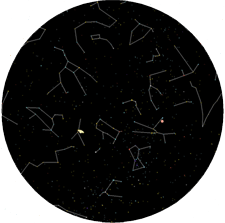 |
||||||||||||||||||||||||||||||||||
|
||||||||||||||||||||||||||||||||||
|
The Planetary Parade Venus rises in the southeast around 5am and hovers low against the horizon before sunrise. Three naked-eye planets are visible this week in the evening sky, although it takes patience and a clear view to the west to spot elusive Mercury, which never strays far from the sun or climbs high above the horizon. Look to the west-southwest a few minutes before sunset, paying attention to the setting sun’s path. Along that imaginary line, a fist-width from the horizon, look for Mercury, as bright as any star, appearing as the sky darkens around 6pm. An hour later Mercury dips from sight. Night by night, Mercury appears a bit higher at sunset over the next week and remains visible a few minutes later. But not for long, as the sun sets later each night closing the gap between its neighboring planet. Sunset finds Mars directly overhead, and the red planet arches high overhead through the evening before setting in the northwest around 1:30am. Saturn shines from sunset to sunrise, appearing high in the east with Cancer the crab come darkness. By midnight the ringed planet is directly overhead, and it sets in the northwest just before daybreak. |
|||||||||||||||||||||||||||||||||
|
|
||||||||||||||||||||||||||||||||||
|
© COPYRIGHT 2004 by New Bay Enterprises, Inc. All rights reserved. |



 At the end of the week, the waning gibbous moon rises a few hours after sunset, around 5:45, and shines until sunrise throughout the week. Friday evening the moon rises with Virgo after 11pm. Look for the first-magnitude star Spica less than one-half degree west of the moon’s darkened disc. The gap between moon and star opens as the two move westward, but only three degrees separate them high in the southwest as dawn approaches. The moon rises in the wee hours after midnight Monday amid Libra, and three degrees above is Jupiter, outshining any star. Look for the two almost due south as morning breaks.
At the end of the week, the waning gibbous moon rises a few hours after sunset, around 5:45, and shines until sunrise throughout the week. Friday evening the moon rises with Virgo after 11pm. Look for the first-magnitude star Spica less than one-half degree west of the moon’s darkened disc. The gap between moon and star opens as the two move westward, but only three degrees separate them high in the southwest as dawn approaches. The moon rises in the wee hours after midnight Monday amid Libra, and three degrees above is Jupiter, outshining any star. Look for the two almost due south as morning breaks.